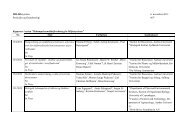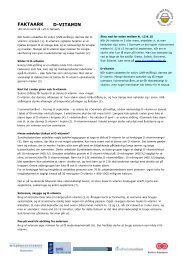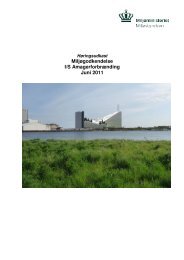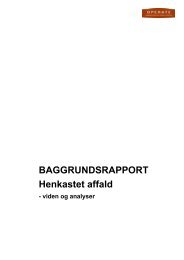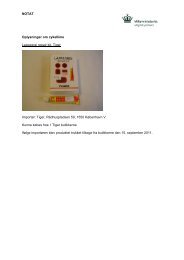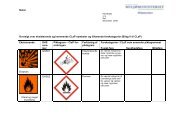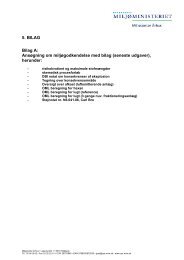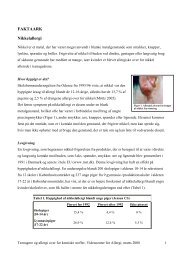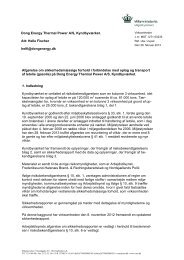Kilder til BAM-forurening - Miljøstyrelsen
Kilder til BAM-forurening - Miljøstyrelsen
Kilder til BAM-forurening - Miljøstyrelsen
Create successful ePaper yourself
Turn your PDF publications into a flip-book with our unique Google optimized e-Paper software.
- The ability of the soil and aquifer to attenuate the pollution (degradation<br />
and sorption of dichlobenil and <strong>BAM</strong>).<br />
The evaluation was carried out by means of mathematical modelling using a<br />
linked aquitard- and groundwater model FRAC3dvs and MOD-<br />
FLOW/MT3D, which include the above mentioned factors of importance for<br />
the durability of the pollution. Model simulations were carried out for geologically<br />
different types of aquifer in order to describe the extent and durability of<br />
<strong>BAM</strong> under various typical Danish hydrogeological conditions. The model<br />
evaluation therefore provides an overall picture of the average extent and durability<br />
of <strong>BAM</strong> in groundwater aquifers with rough intervals for concentrations<br />
and duration of contamination.<br />
The modelling shows how <strong>BAM</strong>-pollutions appear and develop in the<br />
groundwater, and the future evolution is highly varying and dependent on e.g.<br />
the thickness of the overlaying clay aquitard and of the water balance.<br />
The modelling indicates that the maximum <strong>BAM</strong> concentrations will occur in<br />
groundwater aquifers with only a thin or no protecting clay aquitard above.<br />
The highest concentrations are expected in approximately year 2000 and the<br />
concentrations will decrease to below 0.1 µg/l after a period of 20-50 years.<br />
The modelling indicates that groundwater with thick protecting clay aquitards<br />
above will have a breakthrough of <strong>BAM</strong> pollution after many years. For<br />
groundwater aquifers with 30 m of protecting clay aquitard above <strong>BAM</strong> contamination<br />
is only expected after approximately 50 years and hereafter the<br />
<strong>BAM</strong> concentration will slowly increase un<strong>til</strong> the middle next century. However,<br />
the modelling shows that the lowest maximum concentrations in<br />
groundwater occur where the thick inter-layered clay layers are without fractures.<br />
The modelling moreover indicates that the groundwater will be more exposed<br />
to <strong>BAM</strong> pollution underneath aquitards of glacially disturbed clay and heterogenous<br />
clay types containing abundant thin sand layers. In such areas the<br />
model indicates that, other things being equal, there is or there will soon be a<br />
breakthrough of <strong>BAM</strong> to aquifers and following long duration of <strong>BAM</strong> contamination.<br />
The highest <strong>BAM</strong> concentrations appear in groundwater under the urban areas<br />
of the model catchment, while the <strong>BAM</strong> concentrations in the agricultural<br />
areas in general are lower. Lower <strong>BAM</strong>-concentrations and longer distances<br />
between the <strong>BAM</strong> contaminant sources in the agricultural catchment areas<br />
mean a lower frequency of <strong>BAM</strong> findings and shorter durability compared to<br />
the urban catchment areas.<br />
It shall be emphasized that the results of the model are very sensitive and dependent<br />
on the degradation potential of <strong>BAM</strong>. In the laboratory studies no<br />
degradation of <strong>BAM</strong> was observed in experiments representing groundwater<br />
aquifers. However, if <strong>BAM</strong> is degraded in groundwater, the degradation rate<br />
must be very low since the model calibrations with ”no degradation” seem to<br />
fit the actual findings of <strong>BAM</strong> in the groundwater. Nonetheless, the predicted<br />
durabilties of <strong>BAM</strong> pollution are very long, and even a very slow degradation<br />
of <strong>BAM</strong> (e.g. half life of 10 years) in the groundwater would reduce the predicted<br />
extend and duration of <strong>BAM</strong> pollution dramatically.<br />
21





